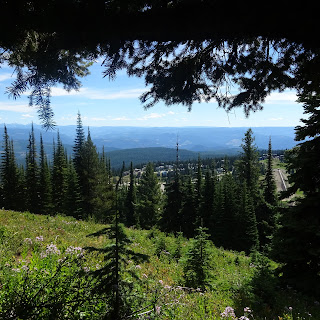Real Estate: 92 listings and 4 viewings later, we have not
yet seen something that grabs us. We do
have 2 viewings tomorrow, but this is turning into a sit-and-wait situation for
the time being. Apparently September is
a time for extra activity, so all is not lost yet.
In the meantime, we have not wasted time. We have joined a gym for a month, starting
Aug 1, and have done three hikes in the last week. (Pictures to follow).
Forest fires: The number of forest fires have dropped, but
we still see haze in the air almost every day, sometimes fairly heavy. There are warning signs and campfire bans
everyone. Given that there is no rain
expected for tomorrow, Vernon will have had no rain in July. This is a huge contrast to the spring, where
they had more meltwater than they had ever seen, flooding, and springs showing
up everywhere. Lake Okanagan water
levels have dropped only last week to allow access to beaches again; many docks
have been obliterated or damaged. In the
meantime, the temperatures go to the low to mid 30’s in the daytime, but fall
to 13 or 14 degrees at night, wonderful for sleeping. Next week may see us in the high 30’s.
Skiing and Silver
Star: We came to Vernon, knowing
that there was a good ski area nearby.
Oddly enough, our apartment is halfway up Silver Star Road to the
resort, and it is only 12 minutes to the ski parking lot.
Silver Star is as busy in the summer as the winter because
it focuses on mountain-biking (huge) and hiking in the summer. The ski chairs have been modified to carry up
four bikes, followed by their riders on the next chair.
The mountain bikers have three levels of trails, easy,
moderate and tough. We have renamed “tough”
to “near death”. They go over jumps,
down big slides, and generally tear around at death-defying speeds. (Old fart
language.) And there are a ton of them.
For those of us who are more sedate, the hiking was
fantastic. We climbed up about 1000
vertical feet, much of which were through conifer forests, but…whenever you got
to an open area, the alpine flowers were at their peak. Lupines, delphiniums, fireweed, hawkweed,
daisies, Indian paintbrush—it was amazing.
The views are spectacular, although hazy at times from woodsmoke.
Dirt: With the dryness, the dust is very, very
fine. It sticks to sunblock,
perspiration, and anything that is within 15 feet of its generation. Showers after the hike seemed to have a lot
of dirty rivers, from top down.
People: When you meet people on the trail, you
talk. It doesn’t matter where they are
from, and this season seems to have a LOT of tourists. That may be the nature of the summer here
regardless. The long-term “Vernonites” (a
proper term according to locals) think the traffic is crazy crazy. It’s nice to interact with everyone.
I’ll try to update on a weekly basis unless something REALLY
exciting happens. Cheers for now!
Oh, by the way, a couple of inspirational signs (not that we are fixated on this subject):
Oh, by the way, a couple of inspirational signs (not that we are fixated on this subject):

















































